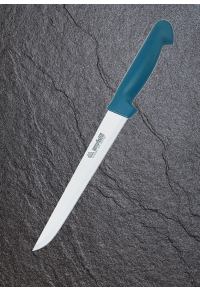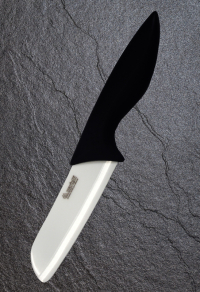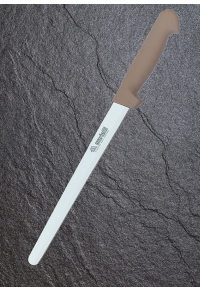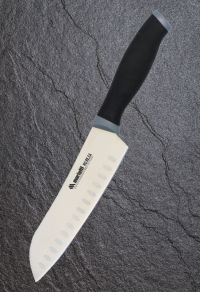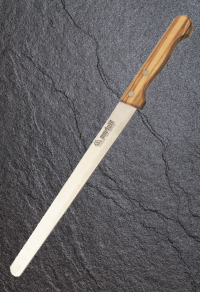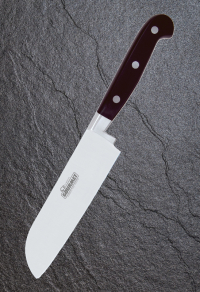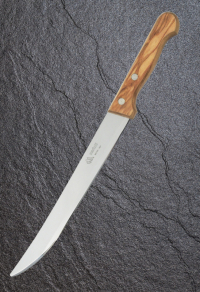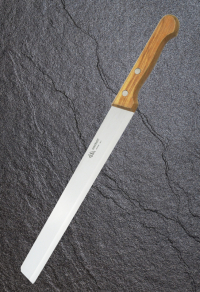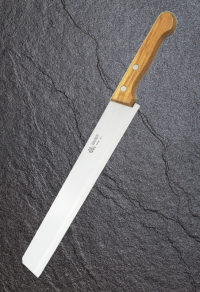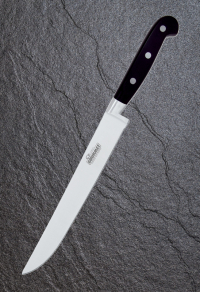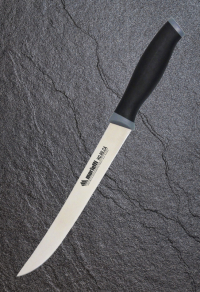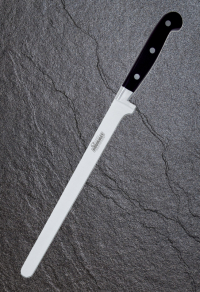
Knives
Subcategories
-
copy of Knife ARROSTO -...
They are knives with a blade geometry designed to offer the least resistance when cutting the food. SPINE and EDGE of the blade, generally "run" in parallel way just for this reason. Extremely sharp and with a tip pointing upwards to facilitate cutting the slices. Blade length between 20 and 30 centimeters.
-
Knife SANTOKU - cod. 134CZ
The Santoku knife represents the Japanese equivalent of the European chef's knife (CHEF KNIFE). Characteristic Japanese knife used to cut and chop vegetables. For this operation - in fact - Western cooks use the knife called CHEF KNIFE The big difference between the two blades is that the carving knife is designed so that the tip always remains in contact with the cutting board, while the Santoku is used as a small cleaver and the tip always comes off the cutting board. -
copy of Knife PROSCIUTTO...
Type of blade fundamental for slicing salami, hams and smoked salmon (in this case the blade is alveolar). Characterized by a long blade that minimizes cut resistance, facilitating the progression and maintenance of the thin thickness required for these foods. Also available flexible.
-
Knife SANTOKU 1235TP
A Santoku has a blade quite similar to a carving knife and is the Japanese equivalent of a chef's knife. Since it is a good idea to have a knife (and a cutting board) for raw food and a knife (and a cutting board) for cooked foods, the second carving knife can be a Santoku so you have the chance to try this type of blade too. The big difference between the two blades is that the carving knife is designed so that the tip always remains in contact with the cutting board, while the Santoku is used as a small cleaver and the tip always comes off the cutting board.
-
Knife PROSCIUTTO SALMONE
Essential for slicing cured meats, hams and smoked salmon if fitted with a blistered blade. Characterized by a long blade that minimizes cut resistance, facilitating the progression and maintenance of the thin thickness required for these foods. Also available flexible. -
Knife SANTOKU - cod. 2016
The Santoku knife represents the Japanese equivalent of the European chef's knife (CHEF KNIFE). Characteristic Japanese knife used to cut and chop vegetables. For this operation - in fact - Western cooks use the knife called CHEF KNIFE The big difference between the two blades is that the carving knife is designed so that the tip always remains in contact with the cutting board, while the Santoku is used as a small cleaver and the tip always comes off the cutting board.
-
Knife ARROSTO
They are knives with a blade geometry designed to offer the least resistance when cutting the food. SPINE and EDGE of the blade, generally "run" in parallel way just for this reason. Extremely sharp and with a tip pointing upwards to facilitate cutting the slices. Blade length between 20 and 30 centimeters. -
Knife SALUMI
Very important for slicing meats and hams and salmon if it has a blistered blade. They have a long (possibly hollow) and very flexible blade. -
Knife PASTA
The type of knives with SMOOTH blades table are suitable for fruit, vegetables and fish (cooked or raw). Sharp and flexible, together with the fork they are a true ally of the palate -
Knife ARROSTO - cod. 2011
They are knives with a blade geometry designed to offer the least resistance when cutting the food. SPINE and EDGE of the blade, generally "run" in parallel way just for this reason. Extremely sharp and with a tip pointing upwards to facilitate cutting the slices. Blade length between 20 and 30 centimeters.
-
Knife ARROSTO 1252TP
ROAST
-
Knife PROSCIUTTO - cod. 2014
Type of blade fundamental for slicing salami, hams and smoked salmon (in this case the blade is alveolar). Characterized by a long blade that minimizes cut resistance, facilitating the progression and maintenance of the thin thickness required for these foods. Also available flexible.















